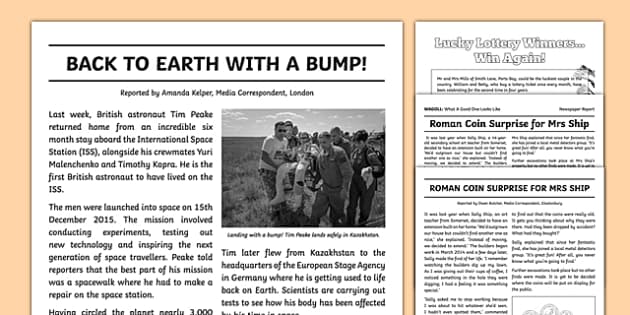News Articles - Questions
Table of ContentsIndicators on News Articles You Need To KnowAbout News ArticlesNews Articles - An OverviewSome Of News ArticlesThe Ultimate Guide To News Articles
Great understanding of various subjects provides trainees an affordable edge over their peers. Although electronic and social media are conveniently available, we need to not neglect how crucial it is to read the papers. Moms and dads have to attempt and inculcate the behavior of reading a newspaper as a daily regimen to proceed the heritage of the revered print medium.Newspaper article additionally contain a minimum of one of the following crucial characteristics about the desired audience: proximity, importance, timeliness, human rate of interest, strangeness, or consequence. The related term journalese is often made use of, generally pejoratively, to describe news-style writing. An additional is headlinese. Papers generally comply with an expository writing design.
Within these restrictions, newspaper article also intend to be comprehensive. However, various other elements are included, some stylistic and some originated from the media form. Among the bigger and much more revered papers, fairness and equilibrium is a significant aspect in providing information. Commentary is generally constrained to a different area, though each paper might have a different general slant.
Newspapers with a worldwide target market, for example, often tend to use a more official design of composing. The certain selections made by a news electrical outlet's editor or editorial board are typically collected in a design overview; typical design guides include the and the United States News Design Publication. The primary goals of news writing can be summarized by the ABCs of journalism: precision, brevity, and clarity.
The Best Strategy To Use For News Articles
Generally, reporters will certainly not make use of a lengthy word when a short one will do. They utilize subject-verb-object construction and dazzling, active prose (see Grammar). They provide narratives, examples and allegories, and they rarely depend on generalizations or abstract ideas. News authors attempt to stay clear of making use of the very same word greater than once in a paragraph (in some cases called an "echo" or "word mirror").
Headings occasionally leave out the topic (e.g., "Leaps From Boat, Catches in Wheel") or verb (e.g., "Feline female fortunate"). A subhead (additionally subhed, sub-headline, subheading, caption, deck or dek) can be either a secondary title under the main headline, or the heading of a subsection of the write-up. It is a heading that precedes the main message, or a team of paragraphs of the primary message.

of a post subject, informant, or interviewee), it is referred to as a drawn quotation or draw quote. Added signboards of any of these types may appear later in the post (specifically on succeeding pages) to lure further reading. Journalistic sites often make use of animation methods dig this to switch one signboard for one more (e.g.
How News Articles can Save You Time, Stress, and Money.
Such billboards are also made use of as tips to the short article in various other sections of the publication or site, or as promotions for the piece in various other magazine or websites. News release of the Swiss government. Typical structure with title, lead paragraph (recap in strong), various other paragraphs (details) and contact info.

Instance of a hard-lead paragraph NASA is proposing an additional area project. The budget plan requests around $10 billion for the job.
The NASA statement came as the agency asked for $10 billion of appropriations for the project. An "off-lead" is the 2nd essential front web page information of the day. The off-lead shows up either in the top left edge, or straight below the lead on the. To "hide the lead" is to begin the write-up with background details or information of additional value to the viewers, compeling them to read even more deeply into a short article than they need to have to in order to find the necessary points.
Not known Details About News Articles
Common usage is that a person or 2 sentences each develop their own paragraph. Reporters typically describe the organization or structure of an information tale as an upside down pyramid. The essential and most interesting elements of a tale are you could look here put at the beginning, with supporting info complying with in order of lessening value.
It permits individuals to check out a topic to only the deepness that their interest takes them, and without the imposition of details or nuances that they could consider irrelevant, yet still making that details available to much more interested viewers. The upside down pyramid framework likewise enables short articles to be trimmed to any kind of approximate length during design, to suit the area offered.
Some authors begin their stories with the "1-2-3 lead", yet there are lots of kinds of lead available. A twist can refer to numerous things: The last tale in the information program; a "delighted" story to end the program.
Longer articles, such as magazine cover short articles and the items that lead the within areas of a paper, are recognized as. Feature stories vary from straight news in numerous ways.
Things about News Articles
A function's recommended you read very first paragraphs often relate an interesting moment or event, as in an "anecdotal lead". From the particulars of an individual or episode, its sight quickly broadens to abstract principles regarding the tale's topic.

The Editor's Toolbox: A Reference Overview for Beginners and Professionals (2001) Allan M. Siegal and William G. Connolly. The New York City Times Manual of Design and Usage: The Authorities Style Guide Utilized by the Writers and Editors of the Globe's The majority of Authoritative Newspaper (2002) M. L. Stein, Susan Paterno, and R.